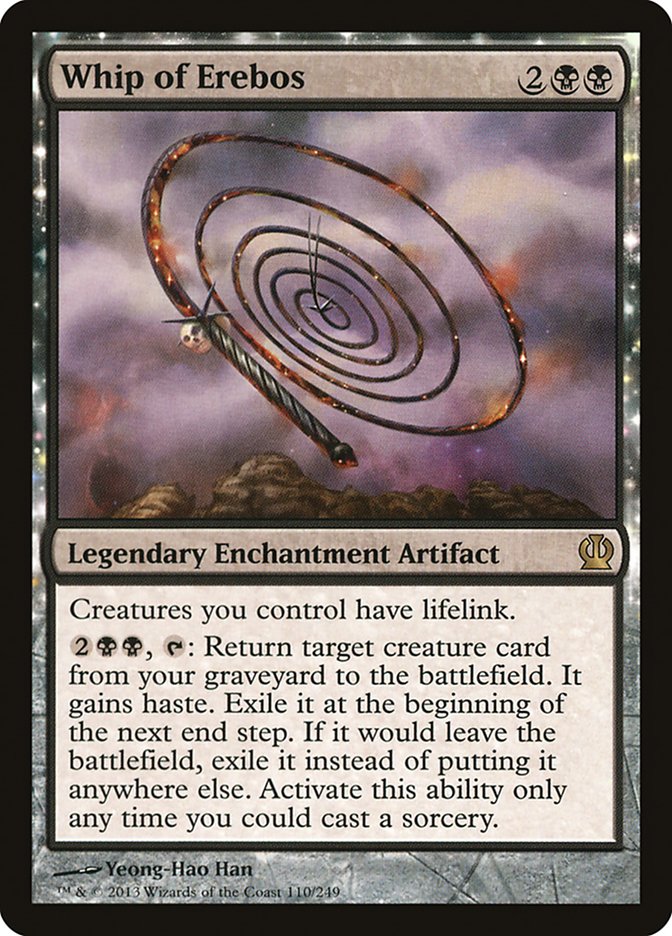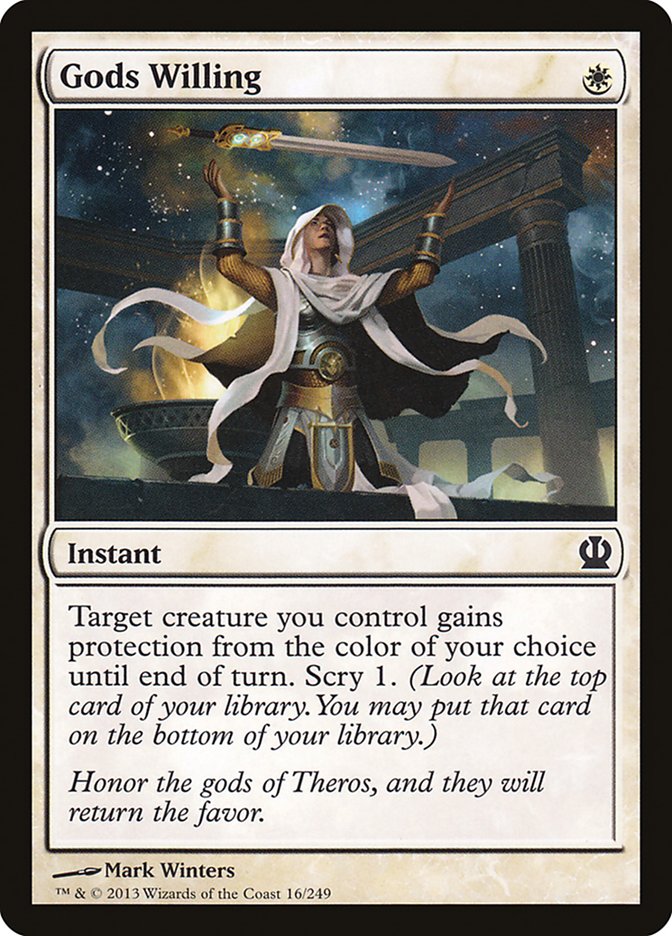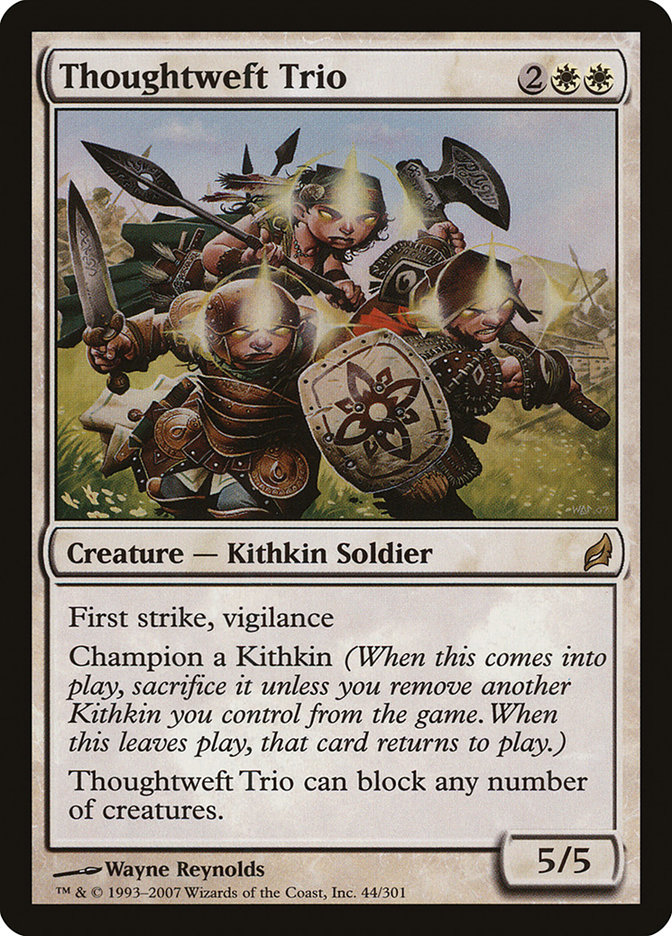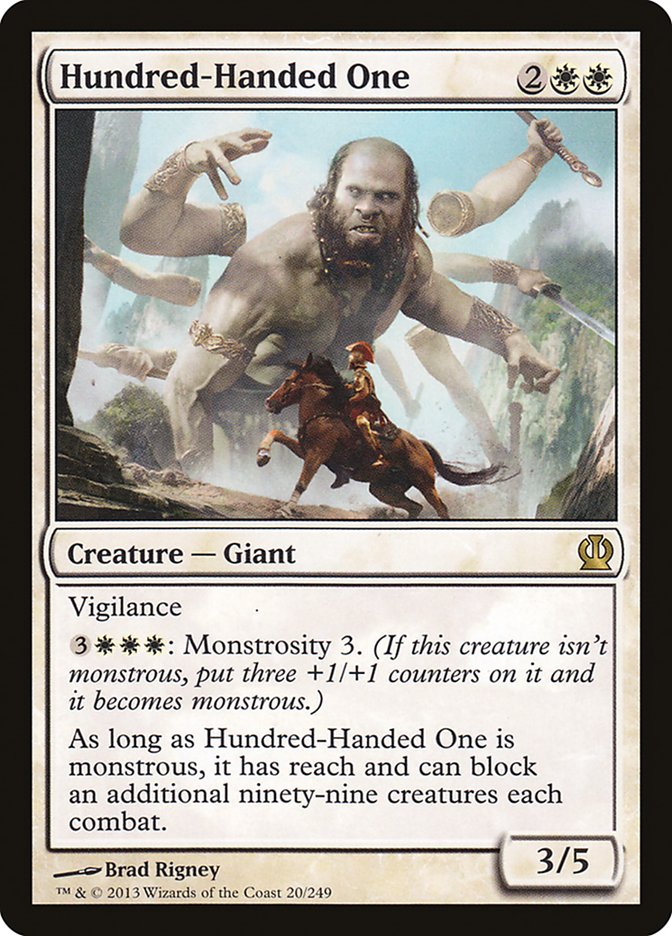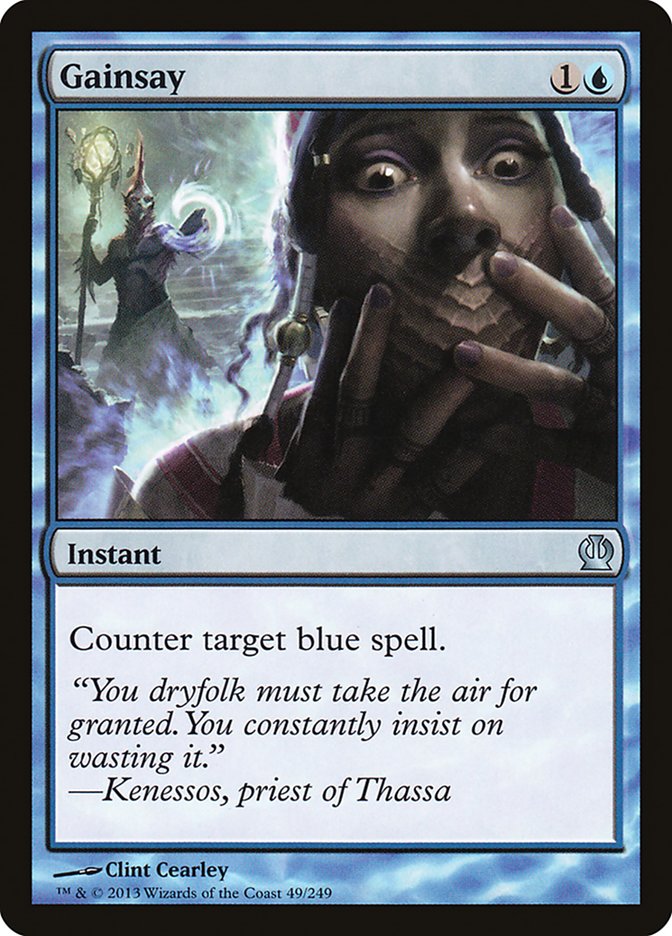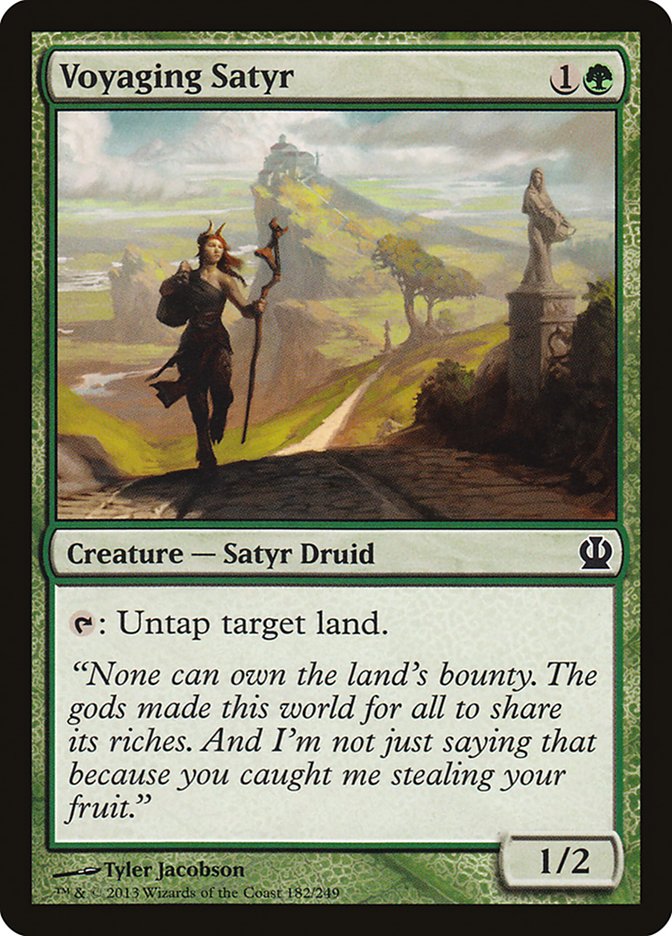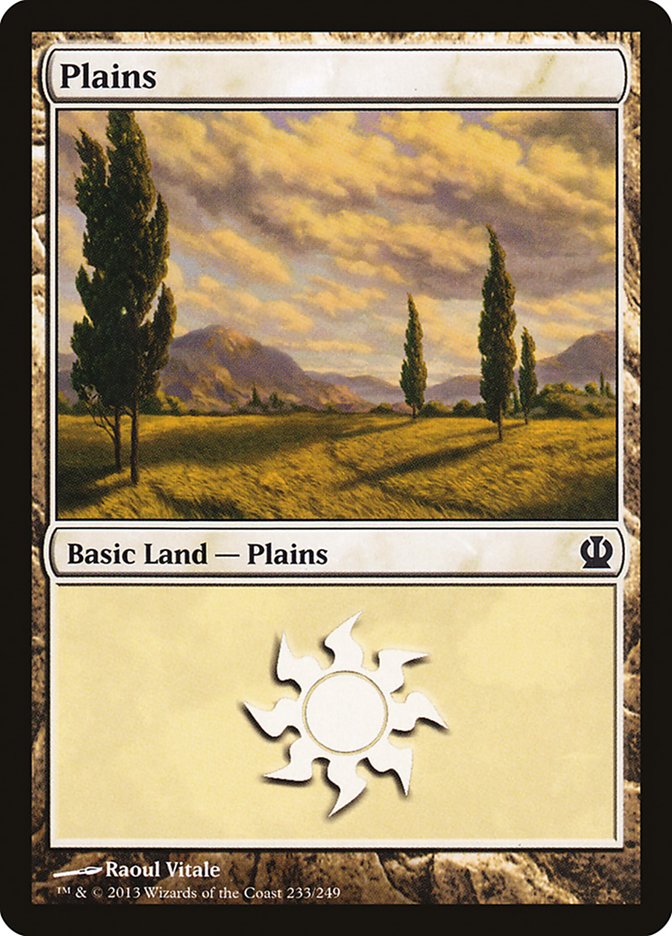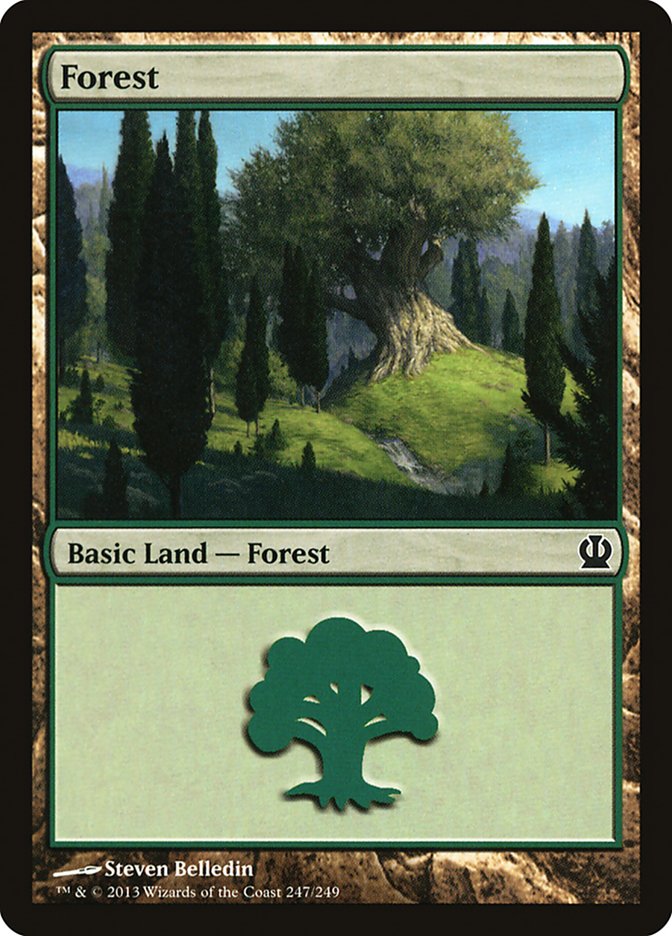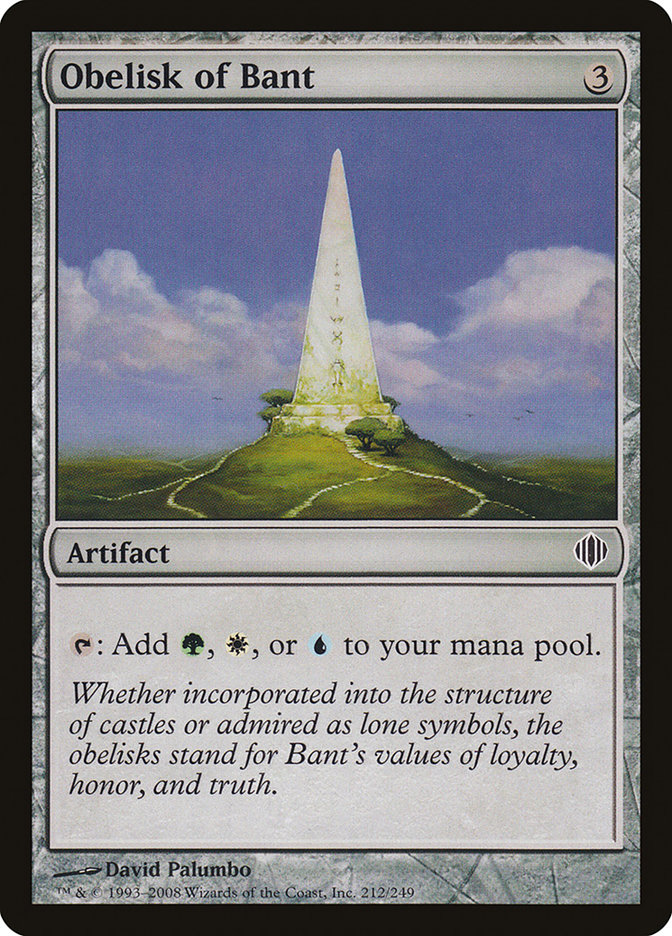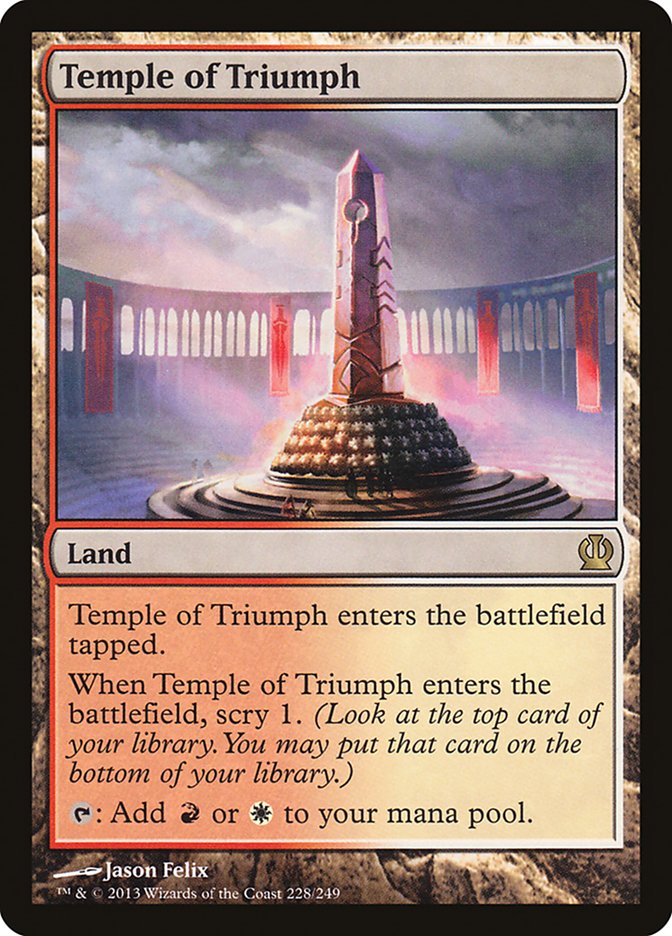Mmm, ambrosia, sustenance of the Greek gods (and fruit salad of mortals). I hope you had a great Prerelease. I . . . well, I don’t know yet because of my writing deadline. I’ll assume mine was good.
Before I get to this most important flavor review of the year—new setting and all that—it’s disclaimer time. I contributed creative text to a Magic: The Gathering card set in Theros block (not Theros itself) and had access to the block’s style guide in advance. I had no specific foreknowledge of cards in this set. For sets where I have advance knowledge of the contents, I am ineligible to play in Prereleases; when I have knowledge of a full set, I will not play in tournaments or distribute decklists to anyone until after its Magic Game Day.
All right, enough of the disclaimer stuff. Let’s celebrate Theros.
General Impressions of Theros
My biggest concern going into the Theros set was that it would try too hard to jam in as many references to Greek myth as possible and not let the "Magic" side of the flavor breathe. Innistrad was chock-a-block with references such as Cellar Door, Creepy Doll, and Jar of Eyeballs. When that top-down model is adhered to without deviation, though, the result is not an Innistrad but a Portal Three Kingdoms, where what could have been rich source material ends up suffocating instead.
At least for now, the Theros setting seems to be resonant rather than stultified. I’ll take it.
Enchantment creatures (and legendary enchantment creatures and legendary enchantment artifacts) are a thing in Theros, and for the most part I’m a fan. I love the starfield effect at the top of the frame; it’s a subtle reminder that dovetails with Nyx, the night sky that is the home of the gods. I’m less enamored, however, of the various weapons of the gods, such as Bident of Thassa, not being Equipment. In a pre-Mirrodin setting they would have made sense, but these cards really fell victim to the type line.
The humans of Theros also share certain physical characteristics. The "imported" planeswalkers, Elspeth Tirel (as depicted on Elspeth, Sun’s Champion) and Ashiok, Nightmare Weaver, have two of the three palest skin tones on Theros—Daxos of Meletis also being in the conversation—and after enough time on the sun-drenched Mediterranean-inspired plane, even Elspeth (as depicted on Gods Willing) gets a tan. Human hair, when visible, is brown-to-black and usually curly, reflecting the appearance of many in southern Europe and northern Africa. Blond hair and blue eyes are rare to nonexistent; no Theros native looks like an import from Viking world.
Card-Specific Notes
White
Celestial Archon – There are no Angels in Theros. Instead there are the Archons, steed-riding former rulers of the cities who are on the jerk side of justice. As for the blind, winged ox this one is riding, I’m at a loss for why a simple pegasus isn’t good enough for it. (Archons. Go figure.)
Chained to the Rocks – A clear reference to Greek myth, but which one? My mind leapt to Andromeda when I saw this card. Others saw the titan Prometheus. Whether this dude’s life is in danger or merely his liver, either way he’s not in for a happy fun time.
Decorated Griffin – New artist Phill Simmer has this card and Minotaur Skullcleaver in Theros. Of the two pieces I prefer the Griffin with its gentle-yet-powerful grace.
Divine Verdict – Normally I don’t mind puns, but I saw this one coming from a mile away, so I didn’t even get a good groan out of it.
Elspeth, Sun’s Champion – Maybe it’s just me, but I find the background of the illustration far more interesting than the planeswalker herself.
Fabled Hero – Along with Chained to the Rocks above and Keepsake Gorgon, one of the art debuts for Aaron Miller. Looking at his portfolio gives me a sense of an artist who knows himself and will deliver like the professional he is. Also, the flavor text? Add it to the "heck yes" column.
Heliod, God of the Sun – There’s a reason the Heliod artwork has been the defining image of Theros. The sense of scale, the star shadows, the landscape . . . it all fits.
Hopeful Eidolon – The art isn’t a printing error. All the Eidolons share this sort of sketchy appearance.
Hundred-Handed One – I like to think the giant’s expression comes from the moment he looks at Thoughtweft Trio and thinks, "Oh sure, they can block a googolplex of Pestermite tokens, but I can’t. Thanks a lot, top-down design!"
Observant Alseid – The nymphs of Theros are the feminine eye-candy this time around. Considering how the ancient Greek artists idealized the human form, I suppose some of it was inevitable . . .
Ordeal of Heliod, Phalanx Leader – . . . But there’s a lot more masculine eye-candy than I ever expected. This set has more bare-chested manliness than a Vladimir Putin fly-fishing photo shoot.
Scholar of Athreos – While the headdress is a bit too harlequin for my taste, it does highlight that Athreos, who seems to be a minor god of the dead, fills the black-white slot.
Silent Artisan – I suppose it was only natural that a plane of epic deeds would have its own epic poem . . . but where’s the poetry? I’m not getting any sense of meter or rhythm or flow from The Theriad.
Spear of Heliod – Yep, I still want this to be Equipment.
Traveling Philosopher – Ok, let’s assume that The Theriad is a prose epic rather than poetry. With that allowance, I like this snippet. Pretty effective.
Yoked Ox – The 0/4 power/toughness throws me here. I don’t care how yoked or docile it is; anything with those horns that gets attacked is going to do some damage in return.
Blue
Annul – In the trailer for Theros, an image of the face of Xenagos is shown while Heliod refers to him as a "usurper." I don’t think he’s winning any brownie points with the pantheon for that quote.
Benthic Giant – One of the most flatly fatalistic flavor texts in recent memory. I really respect it.
Breaching Hippocamp – Along with Loathsome Catoblepas, this marks the Magic debut of Christopher Burdett, a Florida-based illustrator. I like his details, but my worry is how many of those details will get lost at card-size. Then again, first illustrations always are a little wonky, and it takes time to learn how to paint for the card frame. I’m interested in seeing what he does next.
Crackling Triton – I get where the flavor text is going, but it’s just not jelling for me. Perhaps "He was born in the currents of Thassa’s seas. Keranos showed him the currents of the clouds," but I don’t really like that either. There’s promise and it’s just tantalizingly out of reach.
Curse of the Swine – After Innistrad block, I’m conditioned to think of a card starting with "Curse" as an Aura, not a sorcery. "Turn to Swine" was available as a card name; why not that?
Dissolve – Now that’s how to do a one-line flavor text.
Gainsay – What is it with Magic and creepy illustrations involving mouth blockages? (See also: Silence.) Not saying this one’s bad, just . . . creepy.
Master of Waves – I have no idea how this card plays in actual games of Magic. On the battlefields of my Vorthos imagination, though, it’s sheer flavorful fun.
Meletis Charlatan – For a name that’s as evocative as Meletis Charlatan, the flavor text is a bit of a disappointment. It sounds like a scholar’s voice, not a flimflammer’s.
Mnemonic Wall – I wonder if the writer who asked "What’s so confusing about anamnesis?" realized that it refers not only to a theory of Plato’s but also has strong resonance for many branches of Christianity. If so, fifteen meta-points.
Omenspeaker – Sole debut artwork for Dallas Williams. Until I saw the really big version on the website (where it seems the production name for the card was "Oracle of Thassa"), I couldn’t figure out what was going on with Omenspeaker’s lips. Also, was "Forest Nymph" on the same site a rejected Wizards work?
Sea God’s Revenge – As sphinx riddles go, this one’s pretty easy. Interestingly presented, though.
Thassa’s Bounty – So in this clamshell I see a sword, a pearl-topped chess piece, and . . . coral? I’m missing something here.
Triton Fortune Hunter – That so many people mistook this 2/2 for a God—the lack of a starfield effect is the only good clue—indicates just how off the scale it is for a 2/2. (This wouldn’t have made a bad "minor sea-linked god" illustration at all!)
Voyage’s End – This is the first card in the review that really hits me in the gut with all aspects: the epic art, the lamenting name, and the flavor text’s academic high-mindedness and sailors’ practicality. All that on a common card too! I like this one.
Black
Agent of the Fates – At just five words and seven syllables—this would tuck right into the middle line of a haiku—that is some wicked flavor text.
Asphodel Wanderer – Name and flavor text don’t really sync up here. Per the Planeswalker’s Guide to Theros, Odunos is the violent city of the Returned, not Asphodel.
Dark Betrayal – I can see this card in full—name, flavor text, and art—being reprinted in many core sets to come. This one really comes together.
Disciple of Phenax – Phenax must be a minor god and judging by this card (sole mention of Phenax) black-aligned. If Athreos is black-white, Pharika is black-green, and Mogis black-red, that leaves black-blue for Phenax. Hmm. What’s the story?
Fleshmad Steed and Gray Merchant of Asphodel – Not only are these two cards the debuts of Robbie Trevino, but they’re right next to each other. Interestingly, Mr. Trevino’s website lists five illustrations as "MTG," but neither of these two is in the mix. The Fleshmad Steed appears to be a reference to the Mares of Diomedes, who were involved in one of the labors of Herakles/Hercules.
Lash of the Whip – I can only imagine that when Erebos chills with his death priests that everyone stands awkwardly around the wine krater while a kithara player covers "Time Is on My Side."
March of the Returned – The flavor text isn’t high-flying, but it is effective.
Rescue from the Underworld – There are several top-down home runs in this set, and Rescue is one of them. One wonders how often planeswalkers will be more successful in their rescue attempts than Orpheus was with Eurydice . . .
Tormented Hero – Hmm, another sexy shirtless bad-boy painted by Winona Nelson. Who here’s surprised? *crickets* Yep, thought so.
Viper’s Kiss – Aescalos might be the Theros setting’s Jaya Ballard. Might.
Red
Akroan Crusader – Both name and flavor feel "off" here. "Crusader" brings to mind medieval rather than ancient times, while the flavor text seems to suggest that if you’re not a commander you’re nothing in Akros.
Anger of the Gods – That Noah Bradley art and that flavor text? Sign me up.
Arena Athlete – So Iroas is the god of victory. Now, if Anax used to worship Iroas but then switched his allegiance, that doesn’t seem like a good career move for a king, does it?
Borderland Minotaur – The Champion is a woman. Definitely a gender-flip from the ancient epics, but what’s to stop a great Setessan hero from being the Champion? Absolutely nothing.
Demolish – Somehow, it doesn’t surprise me that the classically inclined Volkan Baga would incorporate a reference to the fall of the Colossus of Rhodes into this illustration.
Ember Swallower – Why is the type line Elemental when the art so obviously references a manticore?
Firedrinker Satyr – The art is straight from Creeper Town, and the flavor text just makes it worse. Somehow, I think this satyr and Tibalt, the Fiend-Blooded would be best buds if they ever met.
Lightning Strike – The concepter definitely had a vision for this piece, and Adam Paquette delivered.
Minotaur Skullcleaver – Ok, so minotaurs on this plane are brutes. I think we got that five cards ago.
Peak Eruption – I only hope there are hecklers in the markets of Meletis because the street oracle needs about half a dozen.
Satyr Rambler – This image shows how the satyrs of Theros are closer to Roman fauns (which were conflated with satyrs in that mythology) rather than the original Greek satyrs. While I’m not linking to Wikipedia in this case because just opening up the "Satyr" page gets into not safe for work territory, the original Greek satyrs had horse bits. Then again, so do centaurs, so Magic opting for the Roman side of satyrs makes sense.
Stormbreath Dragon – For everyone who’s been saying dragons have no place in Greek mythology, two words: you’re wrong. Sam Stoddard mentioned in a recent article that the inspiration behind Stormbreath Dragon was Typhon.
Titan of Eternal Fire and Titan’s Strength – The top-down design attitude breaks down on both of these cards. The first is supposed to represent Prometheus, but the ability is so tacked-on that it feels as if it was done to make Prometheus rather than a valued Magic card. As for Titan’s Strength, is the eternally frustrating labor of Sisyphus the right illustration here? Both of these just feel awkward.
Wild Celebrants – Because nothing says "5/3 creature" like flower garlands and petty vandalism.
Green
Anthousa, Setessan Hero – I get where the flavor text is going, but if she’s so often leaving her warriors behind, can she be that great of a leader? A few words switched around would’ve served her better.
Commune with the Gods – The main storytelling mode on cards these days is vignette rather than full-on plot. This flavor text is a slight pull in the other direction, and as a result it has more power than it would have during the Weatherlight saga, for instance.
Hunt the Hunter – An interesting comparison in the flavor text, though one would have to know the Setessan attitude toward tattoos to get whether this is seen as a positive or a negative.
Leafcrown Dryad – Not even Volkan Baga’s gifts can turn that pose into anything but cheesecake.
Nylea, God of the Hunt – Oh hello there, scale birds! I’d missed you! Between the scale birds and the scale trees, I’ll argue for Nylea being the most dramatic art of any of the major gods.
Pheres-Band Centaurs – The Theriad must be in a "snooze stretch" here. Way too many words saying way too little and not even in a way that’s poetically interesting.
Satyr Hedonist – The creepy satyr parade continues. I don’t even want to know what’s running through this dude’s head.
Satyr Piper – Ok, finally it’s the fun-loving side of satyrs. Well, he’s having fun at least . . .
Voyaging Satyr – Humorous flavor text done right. Just read the words I wish I’d written:
Vulpine Goliath – But what does it say? (That’s just the Wikipedia link. I’m not as cruel as Doug Beyer.)
Gold
Akroan Hoplite – The flavor text is on the cusp of overdoing it, but I’m still a fan.
Ashiok, Nightmare Weaver – Ashiok does not like being defined in terms of gender. Ashiok has not stated Ashiok’s position on Spivak pronouns. Ashiok is why Karla Ortiz is one of the best recently added Magic artists in the stable.
Horizon Chimera – Most of Sam Burley’s art doesn’t register with me, but this crane-deer hybrid sure does. I’m impressed.
Medomai the Ageless – The original art for this legendary sphinx sold on eBay for $730 plus shipping. If this card becomes the Constructed staple I think it might be, someone got a heck of a deal.
Sentry of the Underworld – "Griffin Skeleton" is a new combination, and this green-saturated Dave Kendall art rises to the occasion. It’s just recognizable enough to be nightmarish.
Shipwreck Singer – The flavor text pushes a little too far and goes from pathos to bathos, unintentional humor. I won’t be able to think of this card without also recalling a certain Family Guy clip . . .
Triad of Fates – I’m not the first to comment about how young and shapely all the Fates look. While this doesn’t correspond with the Greek Fates, I’m willing to accept this as a liberty taken with Greek myth. It certainly isn’t the biggest one in the set.
Tymaret, the Murder King – Had the art and flavor text been bad, the name would’ve wound up laughable. Instead, this is one of the most awesome cards in a set designed to turn the awesome up to eleven.
Xenagos, the Reveler – The planeswalker card of the setting’s major antagonist. He looks the part too; he practically has "jerk" written all over his face. I don’t know where his story will go, but the only chance I have of liking him is if I love to hate him.
Artifact
Akroan Horse – The Trojan Horse of the Theros setting. I was hoping it would turn out a little more impressive, but so it goes.
Colossus of Akros – Another reference to the Colossus of Rhodes . . . and a bit more monstrous, if you’ll pardon the pun.
Guardians of Meletis – Word of Doug Beyer is that this is the first canonical reference to a same-sex couple in Magic. On the art front, this is the sole debut card for Magali Villeneuve, a French illustrator.
Opaline Unicorn – It took long enough to get to the gods’ dalliances with one another. This piece shows off the artistic side of Purphoros, who is a more "collected" red force than usually seen.
Prowler’s Helm – At first, the use of "noose" threw me here, as executions by strangulation in ancient Athens happened slightly differently. The Romans did have the laqueus though, a lasso or noose, and strangulation was one of the methods of execution during the Republican time. I’ll give this a pass.
Land
Basic lands – On the whole, I’m not as thrilled with the basics this time as I usually am. Taken alone the art certainly isn’t bad; getting Rob Alexander back for a variety pack of basics is a good time, and Magic can use more Steven Belledin basics. Together, though, the art shows a little too much style-guide sameness. Think about the skinny conic trees in the Alexander and Belledin Forests, the oddly phallic rocks in the Belledin and Adam Paquette Islands, the sameness of the landforms in the Alexander and Belledin Mountains, and the Alexander and Raoul Vitale Plains where we see more of those skinny conic trees.
The trees are little, but are they happy?
My favorite basic land is the Adam Paquette Plains. Not only does it stand on its own merits as a landscape, but it also puts a more visually interesting spin on the basic land type usually known for "flat and endless."
Nonbasic lands – What surprises me most here is how few of them look like lands at all. Temple of Abandon has so many people in it that it could be an Aura with enchant land or a sorcery just as well as a land. ("I cast Waiting for Godot.") Temple of Deceit is a corner of a room, not a full land, and as for Temple of Triumph, did Elspeth bring the Obelisk of Bant with her on her planeswalking journey?
There are exceptions, of course, none so remarkable to me as Noah Bradley’s Temple of Mystery.
The Wrap
Overall, I’m happy with Theros. It avoided a lot of the pitfalls I feared, hit most of the mythological high notes, and even gave us this ridiculously cute boar token.
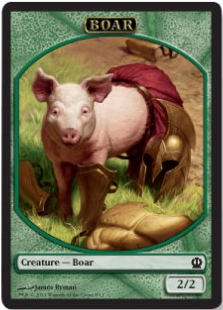
If you have three hours to spare among all the Magic-making, my recommended opera for today is Nixon in China by John Adams. A relatively recent performance at the Met, about three hours long, is on YouTube. You’ll know within the first ten minutes if it’s for you.
As always, thanks for reading.
— JDB
@jdbeety on Twitter

